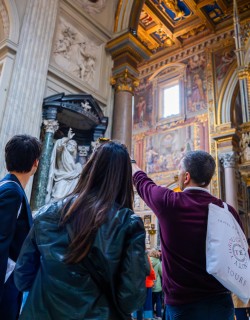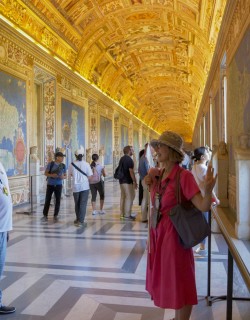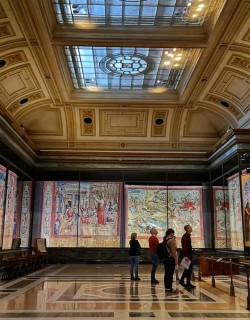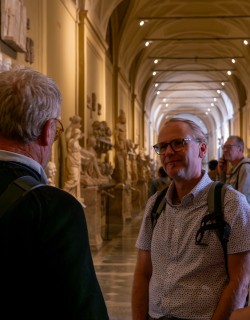In this second instalment of our series pointing out some of the fascinating details easy to overlook on your way through the Vatican museums, we reveal a dramatic tale of vandalism, art and violence unfolding in the magnificent surroundings of the Raphael Rooms. Remember to purchase your tickets for the museums in advance online in order to skip the entrance lines. Or better yet, enjoy the brilliant guidance on one of our Vatican tours, uncovering this and many more secrets of the Vatican Museums.
What comes to mind when you think of graffiti?
The side of a New York subway car? An iconic Banksy in east London, or perhaps the arcane symbols sprayed onto the walls of an on-trend Testaccio cocktail bar? So far so modern.
What about Raphael, the great genius of Italian Renaissance art? Or Martin Luther, the foundational figure of the Reformation in the 16th century? Probably less so. But graffiti has its own fascinating hidden history, and one of its most dramatic chapters plays out in the Vatican Museums with these most unlikely of protagonists.
Within the spectacular suite of rooms decorated by Raphael in the Vatican for Pope Julius II at the start of the 16th century, his sober Disputation of the Holy Sacrament is unlikely to be the first fresco to capture your gaze. An array of holy figures including Adam, Moses and Dante engage in learned debate about Transubstantiation, the moment when bread miraculously transforms into Christ’s body during the Catholic mass. Compared to the iconic School of Athens that faces it on the Stanza della Segnatura’s opposite wall, where the great philosophers of ancient Greece debate the mysteries of the universe in the guise of illustrious Renaissance artists such as Michelangelo and Leonardo da Vinci, the Disputation’s complex theological message might seem rather dull. But give it a second glance: for those who know where to look, this fresco preserves the memory of a historical drama more gripping than anything even Raphael himself could bring to life. Faintly visible etched into the plaster at the base of the fresco are six letters in elaborate gothic script: LUTHER.
In May 1527, only 17 years after Raphael completed his work, the vast and unruly army of the powerful Emperor Charles V, a motley crew of German, Spaniard and Italian mercenaries, sacked Rome. The assault was brutal and swift: by the time the orgy of bloodletting finally ended, nearly half of the city’s population lay dead in the streets. The infirm of the hospital of Santo Spirito - located nearby St. Peter's Basilica - were slaughtered in their beds, and the young residents of the city’s orphanage were thrown screaming into the Tiber. ‘The stench,’ according to one visitor, ‘was terrible.’ Whilst dogs gnawed on the heaving piles of corpses, the victorious soldiers lazily amused themselves swigging pilfered wine and playing games of dice. As an eyewitness recounted in his diary, ‘hell itself was a more beautiful sight to behold’ than the city in those blood-soaked days.
Although the majority of the besieging forces were probably motivated by nothing more than base desires of greed and the spoils of war, the fearsome Lutheran mercenary knights that made up some of their number saw an opportunity to demonstrate once and for all that the golden age of the Roman church had passed. Dressed in stolen vestments, the soldiers conducted mock papal conclaves and travesties of the mass, killing monks and extorting priests. One snatched the spear that pierced Christ’s side on Calvary from its altar in St. Peter’s Basilica, and rode through the Borgo holding it aloft before him. Lead seals were ripped from papal decrees and re-used to make cannonballs, and some soldiers even attempted to extract the golden threads from Raphael’s priceless tapestries hanging on the walls of the Sistine Chapel. Efforts to burn them in order to obtain their gold apparently failed, and the tapestries were eventually carried away as loot by the emperor’s soldiers and sold to the highest bidders.
The pope himself was nowhere to be seen - at the first sign of trouble, he hurriedly fled from the Vatican to the fortress of Castel Sant’Angelo via a secret covered passage. In a gesture vividly showcasing his impotence at the unfolding events, the Sistine Chapel was used to stable the army’s horses. So too were the pope’s palatial living quarters decorated by Raphael nearby. Manuscripts torn from the shelves of the Papal library were spread upon the floors and used as litter for the animals. And so we are returned to Raphael’s great frescoes, silent witnesses to this tale of carnage. Incised into the wall at the base of the Disputation, whose assertion of the Catholic doctrine of Transubstantiation was fiercely rejected by Protestant theologians, is the name of Martin Luther himself.
According to the artist Benvenuto Cellini, the graffiti had been idly carved into the plaster by the pike of a Lutheran knight as he tended to his steed, a kind of tagging that would be as home in the 21st century as it was in the 16th. For many observers, the devastation wrought on Rome by the avenging angels of the north seemed to emblematise the wrath of God himself punishing a city that had fallen into irredeemable vice. The airy splendours of the High Renaissance, the amazing cultural moment that fostered Michelangelo’s Sistine ceiling and Raphael’s Stanze, had been brought to a sudden and terminal full-stop by the Sack of Rome, personified in the defacing traces of a German pike still visible today.
Read more about the hidden secrets of the Vatican Museums in the first entry in our series!



